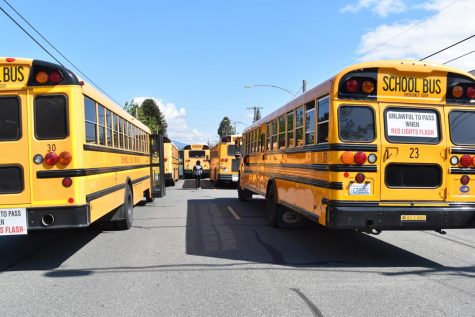The New “Normal”
Students take their temperature after the return to hybrid in April.
May 14, 2021
In March Sedro-Woolley High School joined the rest of the Sedro-Woolley school district in implementing hybrid learning, a full year after remote learning began. The elementary schools in the district, as well as Cascade Middle School, welcomed students back in late February with their own hybrid model.
Shortly after beginning hybrid learning, Sedro-Woolley High School transitioned into a full time in-person model. The switch was temporary, however as cases in the district steadily increased. The high school is now in a modified half day schedule, with cohorts attending either morning or afternoon classes, as confirmed cases continue to grow. As of May 14, there are 80 confirmed cases district-wide, according to the district website which updates cases every Friday.
Despite concerns over the number of cases in both staff and students, administration is doing everything they can to continue in-person learning.
Many staff members feel that hybrid is a more effective method of learning as it allows teachers to better gauge student progress and engagement, as well as better support them.
“In most situations I feel that in person instruction is a much stronger model for student learning. It allows for much more discussion and higher level thinking and collaboration,” said Brian Isakson, principal of Evergreen Elementary School. “It’s really hard especially for younger kids to learn through zoom. It also allows us to support students who are struggling academically or emotionally.”
Laura Davis, principal of Cascade Middle School echoed these sentiments, expressing the importance of in-person instruction. “We feel it is important to be safely in-person as much as possible for everyone’s social, emotional, and mental health,” said Davis. “Academically, it is much easier to determine the level of learning and understanding when the teacher-student interaction is instant and observable in a classroom.”

As a parent, Rebecca Lewis, a teacher at Cascade Middle School, is cautious but glad to see her children enjoying school. “They are happy seeing their friends and getting into normal routines even though nothing is normal. I am monitoring the school protocols heavily, asking my own kids how safe they feel, they wash their hands and change clothes after school, and we spray down their backpacks.”
In order to achieve these in-person connections, all schools have strict health precautions in place in order to keep students and staff safe. These regulations are based off the guidelines set by the Washington Health Department, as well as district collaboration with the local department of health, Skagit County Health.
Phil Brockman, the superintendent for this difficult and uncertain time, worked closely with the health department workers to determine and integrate the current regulations.
“The basics are social distancing at six feet, face coverings masks/shields, frequent washing of hands, cleaning of surfaces with disinfectant, attestations, and having small groups of students,” said Brockman.
Many schools in the district have also added their own safety precautions, especially when it comes to lunch time. During lunch students must remove face coverings in order to eat, which increases the risk of a spread. In order to combat this, administration has come up with their own systems.
“We have four lunches, with 7th and 8th grade students arriving and leaving at different times. It’s a bit chilly at times, as our garage doors to the courtyard are open for ventilation,” said Davis. “While eating, only two students are allowed to sit at marked spots at most of our tables.”
At Evergreen Elementary, staff took another approach. “Lunches are delivered to the classrooms, so after recess the students go through a handwashing process back in their classroom. Once they’re seated with their lunch they’re allowed to remove their mask, eat, and then re-mask up. Then there’s a process for them to re-wash their hands after they’re done,” said Isakson.
As optional in-person learning continues in the district, the CDC released some surprising information that could have an important impact on how school looks in the future.
The Pfizer-BioNTech vaccine, previously approved for ages 16 and up, has now been approved in adolescents age 12 and up. The FDA and CDC approved vaccine has been recommended for use in children 12-15 right away. The CDC has also released a statement saying that fully vaccinated peoples can safely resume most indoor and outdoor activities without a mask.
We have yet to see how these latest COVID-19 developments will effect the future of learning during a global pandemic for schools specifically, but they do inspire hope for a return to normal.



